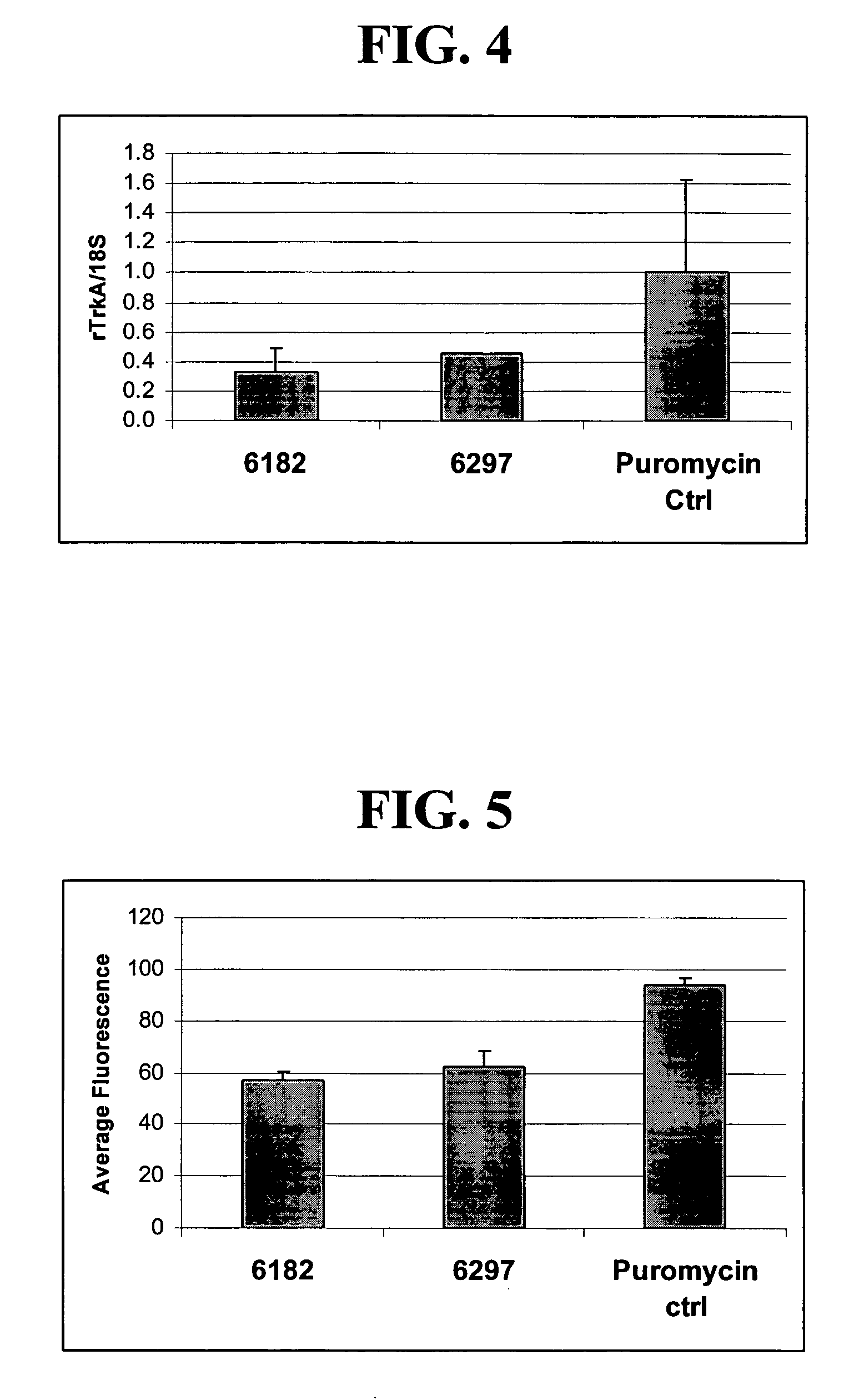Treatment of neuropathic pain with zinc finger proteins
a technology of zinc finger proteins and neuropathic pain, which is applied in the direction of peptide/protein ingredients, drug compositions, peptide sources, etc., can solve the problems of low treatment efficiency, low treatment efficiency, and low treatment efficiency
- Summary
- Abstract
- Description
- Claims
- Application Information
AI Technical Summary
Problems solved by technology
Method used
Image
Examples
example 1
Materials and Methods
A. Cell Culture and Transfection
[0224]Rat C6 cells were cultured in DMEM with 10% FBS. Nucleofection was carried out according the manufacture's protocol (Amaxa Biosystems, Cologne, Germany). In brief, 2×106 cells and 2 μg plasmid DNA were mixed with 1001 μNucleofector Solution V. After electroporation with the Nucleofector program U-30, the cells were plated into 6-well plates. Cells were harvested 72 hours post-transfection.
[0225]Rat ND8 / 34 cells were cultured in DMEM with 20% FBS. Cells were seeded into 24-well plates at the density of ˜1.5×105 cells / well 16 to 24 hours prior to transfection. Duplicate transfections were performed for each construct using FuGENE 6 transfection reagents (Roche, Indianapolis, Ind.). 0.25 μg of the ZFP-TF expression plasmid or control plasmid and 0.05 μg of the puromycin resistance plasmid were transfected into each well using 0.75 μl of Fugene 6 reagent. Transfection reagent-containing media was removed after 8-16 hours and fre...
example 2
Repression of VR1 in C6 Cells
[0235]Fusion proteins comprising 6-fingered zinc finger proteins designed to recognize a target site in rat VR1 (rVR1) and a repression domain were designed as described above in and in U.S. Pat. No. 6,607,882. The designed ZFPs and the target sites recognized by these ZFPs are shown in Tables 1 and 2. In order to test the ZFPs designed as above and shown in Tables 2, the following experiments were conducted.
A. Gene Expression
[0236]Sequences encoding a fusion protein comprising a rVR1-targeted ZFP (6150, 6332, 6337 and 6338) and a repression domain (KOX) were introduced into a pcDNA3.1 plasmid backbone (Invitrogen, Carlsbad, Calif.) to create rVR1-targeted ZFP expression plasmids. The fusion proteins were designated 6150-KOX, 6332-KOX, 6337-KOX and 6338-KOX. Empty pcDNA3.1 plasmid vectors were also prepared for use as controls.
[0237]Plasmids vectors including one of 6150-KOX, 6332-KOX, 6337-KOX and 6338-KOX were transfected into cultured Rat C6 cells as ...
example 3
Repression of TRKA Expression
A. Gene Expression
[0242]Expression plasmids comprising ZFP repressors shown in Table 3 were transfected into ND8 / 34 cell cultures (mouse neuroblastoma / rat DRG neuron hybrid cell line) using the Fugene 6 reagent. To increase the proportion of cells having received the expression plasmid, a puromycin-resistance plasmid was co-transfected with either the ZFP plasmid or the control vector. Cells were selected with 2 μg / ml puromycin for two days to kill untransfected cells. As shown FIG. 4, 6182-KOX and 6297-KOX down-regulate the expression of rTrkA at the mRNA level.
B. Protein Expression
[0243]Repression of rTrkA was also demonstrated at the protein level. ZFP repressors expression plasmids were transfected into ND8 / 34 cell cultures using Fugene 6 reagent. To increase the proportion of cells having received the expression plasmid, a puromycin-resistance plasmid was co-transfected with either the ZFP plasmid or the control vector (cells were selected with 2 ug...
PUM
| Property | Measurement | Unit |
|---|---|---|
| pH | aaaaa | aaaaa |
| temperature | aaaaa | aaaaa |
| pressure | aaaaa | aaaaa |
Abstract
Description
Claims
Application Information
 Login to View More
Login to View More - R&D
- Intellectual Property
- Life Sciences
- Materials
- Tech Scout
- Unparalleled Data Quality
- Higher Quality Content
- 60% Fewer Hallucinations
Browse by: Latest US Patents, China's latest patents, Technical Efficacy Thesaurus, Application Domain, Technology Topic, Popular Technical Reports.
© 2025 PatSnap. All rights reserved.Legal|Privacy policy|Modern Slavery Act Transparency Statement|Sitemap|About US| Contact US: help@patsnap.com



